Utility-Based Joint Scheduling Approach Supporting Multiple Services for CoMP-SUMIMO in LTE-A System
Borui Ren,Gang Liu,and Bin Hou
(Beijing University of Posts and Telecommunications,Beijing 100876,China)
Utility-Based Joint Scheduling Approach Supporting Multiple Services for CoMP-SUMIMO in LTE-A System
Borui Ren,Gang Liu,and Bin Hou
(Beijing University of Posts and Telecommunications,Beijing 100876,China)
In this paper,we study utility-based resource allocation for users supporting multiple services in a LTE-A system with coordinated multi-point transmission for single-user multi-input multi-output(CoMP-SU-MIMO).We designed Joint Transmission Power Control(JTPC)for the selected clusters for minimizing power consumption in LTE-A systems.The objective of JTPC is to calculate the optimal transmission power for each scheduled user and subcarrier.Moreover,based on the convex optimization theory,we propose the dynamic sector selection method in which the average sector throughput and cell-edge users(UEs)rates are performed to achieve the optimal solution.Simulation results show that the system performance achieved by using the proposed suboptimal algorithm is close to that achieved by the dual decomposition method.
CoMP-SU-MIMO;multiple services;scheduling algorithm
1 Introduction
Multiple-input multiple-output(MIMO)spatial multiplexing has the potential to dramatically improve spectral efficiency for future communications and networking[1].However,it may be ineffective when interference levels are high.Suitable processing methods at the transmitter side are thus expected to sup-press interference to successfully deploy MIMO spatial multiplexing in cellular environment[2].
Coordinated multi-point(CoMP)transmission/reception was proposed to mitigate inter-cell interference(ICI)by applying the signals transmitted from other cells to assist the transmission instead of acting as interference[3],[4].According to information shared between coordinated base transceiver station(BTSs),CoMP is mainly characterized as coordinated scheduling(CS)/beamforming or joint processing/transmission(JP)[3]. The class of JP is employed in our work.In this class,data intended for a particular user(UE)is shared among different BTS and is jointly preprocessed at these BTSs.On the other hand,these BTSs can serve a single UE as in the CoMP-singleuser(SU)-MIMO mode,or serve multiple UEs simultaneously in the CoMP-multi-user(MU)-MIMO[4].We focus on the downlink CoMP-SU-MIMO transmission scheme.
However,beyond efficiency and robustness to ICI,next-generation wireless networks are challenged by the demand for multiple services[5].Resource-scheduling algorithms have been created to solve subcarrier assignment problems for heterogeneous services in MIMO-Orthogonal frequency-division multiplexing(OFDM)systems[6],OFDM-based distributed antenna systems(DAS)[7],and OFDM-based cognitive radio multicast networks[8].In a CoMP-SU-MIMO system,a series of efficient resource allocation algorithms have been studied. A dynamic clustering approach in wireless networks with multi -cell cooperative processing is proposed in[9].In[10],a flexible frequency allocation plan(FFAP)has been proposed.A novel transmission scheme with joint Proportional Fairness(PF)scheduling algorithm for CoMP-SU-MIMO has been proposed in[9].
These schemes improve cell-edge efficiency and average sector throughput.However,the main limitation of the algorithms in[9]-[12]is that resource scheduling is designed according to full-buffer model and no multi-service scenario is undertaken.
In this paper,a utility-based scheduling algorithm supporting heterogeneous services for CoMP-SU-MIMO is proposed. The scheme considers not only guaranteeing the system spectral efficiency but also the greater gain improvement with the technology of CoMP.It does not allocate dedicated frequency to cell-edge UEs but treats cell-center UEs and cell-edge UEs equally in every time-frequency resource block(RB)and dynamic CoMP cluster selection method is employed.Two kinds of users are considered:delay-tolerant users(DT-UEs),who require delay-tolerant services such as FTP and email services;and delay-sensitive users(DS-UEs),who require delay-sensitive services such as video streaming.By using Queue Theory to transform delay constraints of DS-UEs into rate constraints,the utility-based scheduling problem is formulated into a mixed -integer nonlinear optimization problem.Using convex optimization theory and dynamic CoMP mechanism,the dual decomposition method combining with CoMP-SU-MIMO is proposedas a solution.
2 System Model
We focus on the downlink of a cellular network with M hexagonal cells,and each cell is partitioned into three base station sectors with k active users served within the coverage of each base station sector(BSS).The base station sectors are assumed to share the same bandwidth B,and the corresponding maximum transmission power P is regarded as uniformly distributed.According to service requirement,users are either homogeneous service users with the File Transfer Protocol(FTP)or multiple services user with video traffic and FTP(Fig.1).
According to[13],when continuous rate adaptation is adopted,the achievable throughput of user k on the n th subcarrier is
whereγn,kis the current SNR for userkon thenth subcarrier andβis a constant related to the target BER by

2.1 Non-CoMP SU-MIMO System
Considering of channel gain,the received signal of userk in BSSmbased on non-CoMP SU-MIMO mode is:

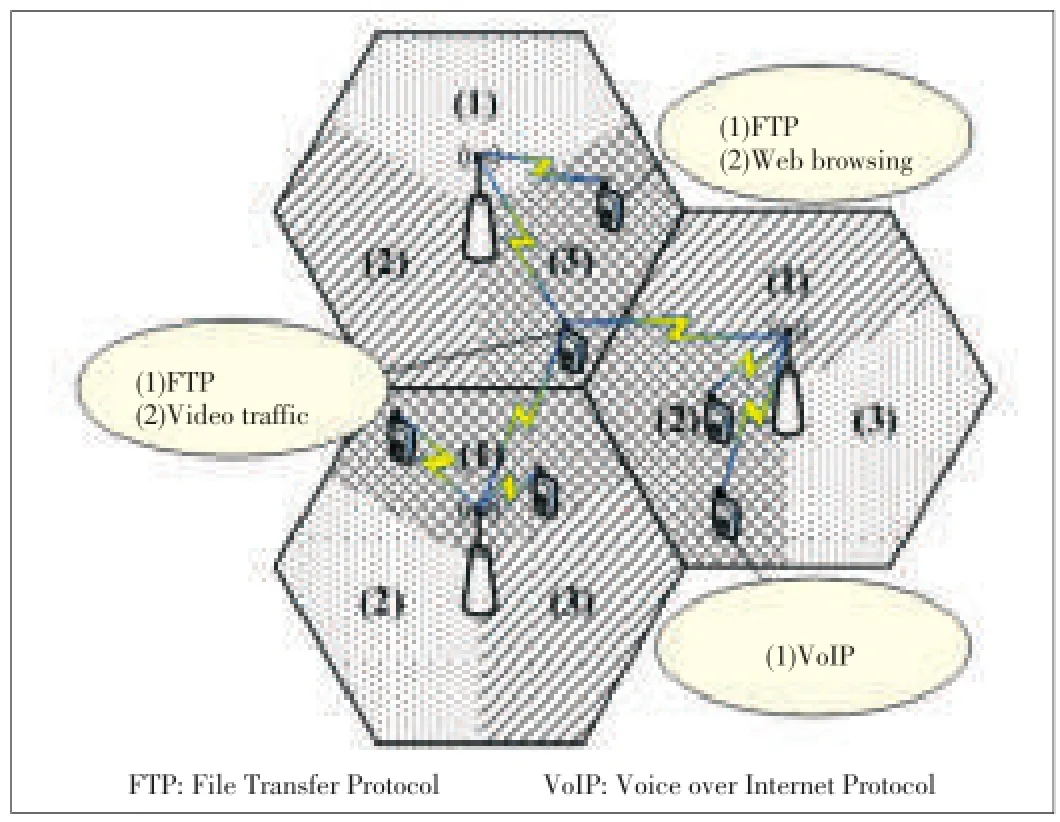
▲Figure 1.Multiple services for the users in CoMP-SU-MIMO system.
2.2 CoMP SU-MIMO System
According to the interference power queen,a dynamic cluster consisting of two or three base station sectors is considered in the CoMP SU-MIMO mode.The central unit(CU)determines user schedule and power control for all base station sectors in each cluster.
The received signal of userkin base station sectorc based on CoMP SU-MIMO mode can be expressed as:
1)Two-BSS cluster

2)Three-BSS cluster

We focus on the downlink of a dynamic CoMP cluster consisting of two or three neighboring base station sectors.According to the long-term channel gain,users are cell-center users(CCUs)or cell-edge users(CEUs).Joint transmission can only be applied to CEUs.In this paper,we focus only on CEUs.The base station sectors are assumed to have one directional transmit antenna each with the same fixed maximum transmission power P and share the same cell-edge bandwidth B.The CEUs are further divided into BE users and VoIP users based on the services they require.Each CEU has one receive antenna and can receive signals from a subset of the base station sectors of the CoMP cluster.
3 Problem Formulation for Multiple Services
3.1 Utility-Based Subcarrier Allocation and Sharing for Homogeneous Services
There are k users in each BSS,and the frequency band consists of N subcarriers.We consider the set of users as K={1,2,…,k}and the set of subcarriers as N={1,2,…,n}. Let Akrepresent the best-effort services set of userkand skbe the cardinality of the set.According to Utility Theory,the utility function for best-effort service is given as algorithm form with respect to average data rate.DefineUkto be the total utility function of userk,which can be expressed as:


We definegn,kas a subcarrier allocation indicator variable. gn,k=1means that subcarriernis allocated to userkfor packet transmission,or else gn,k=0.For any subcarriern,.To avoid co-channel interference,each subcarrier is allocated one user at most.bk,jis assumed to be the assigned transmission bits for service j of user k and bk,j≥0. Considering that the available throughput of userkon all allocated subcarriers is generally equal to the assigned transmission bits for all services of user k,we have.Then,can be updated:

where T is the time slot duration.
Substituting(7)into(6),we get:

where

3.2 Scheduling Algorithm for Multiple Services
Compared with best-effort service,user experience mainly depends on delay restriction,which is related to deadline.Owing to the provision of buffer for each service,the scheduling scheme for delay-sensitive service should transmit packets before deadline rather than as soon as possible.In terms of headof-line(HOL)packet delay(Fig.2),the delay-sensitive service is divided into three parts:absolute priority services(APS),relative priority services(RPS),and common priority services(CPS).djis the transmit deadline of the HOL packet of delay sensitive servicej,and J1and J2(0≤J1≤J2)are two parameters.
The available subcarriers for the SU are firstly assigned to APS until the HOL packet delay is out of[dj-d1,dj].The remaining subcarriers are allocated among best-effort services,RPS,and CPS,which are all reckoned as best-effort services. The optimal resource allocation problem is given by:
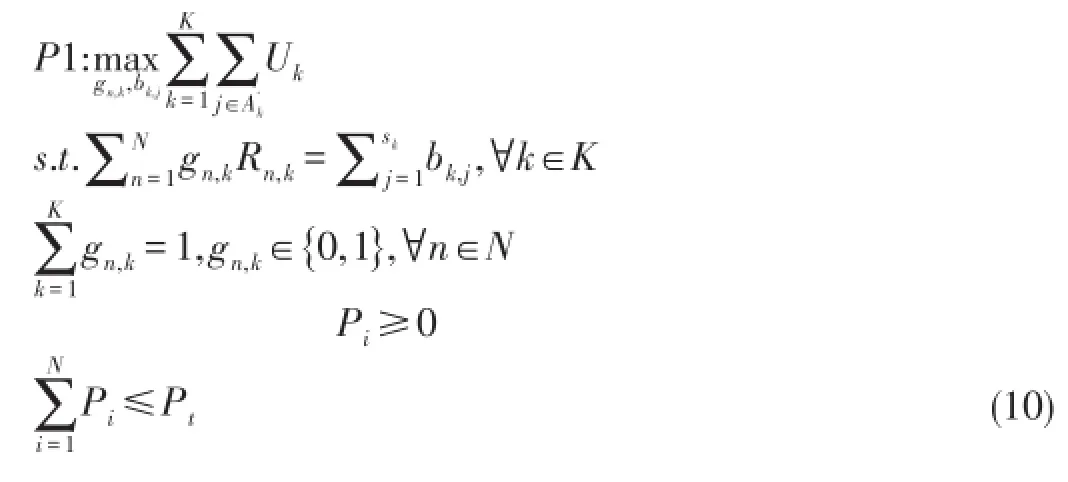
Theorem 1:Definek*as the user that subcarriernis allocated to,the optimal SU with best effort services to maximize the utility function is:

Algorithm 1 the MUMS algorithm
1:subcarrier set:N'={remainingavailablesubcarriers},user set:K''=K-K'

▲Figure 2.Priority of delay sensitive service.
3:1)randomly select a subcarriern*∈N',and identify an optimal user k*∈K''such that

2)assign subcarriern*to userk*
3)N'=N'-n*
Theorem2:In a heterogeneous service cognitive radio(CR) system,set the subcarrier allocationfor user k.In order to maximize the utility of userk,the optimal subcarrier sharingBkis

where μ satisfies the maximum available throughput constraint.The Maximum Utility for Multiple Services(MUMS)resource allocation scheme is presented in Algorithm 1.
4 CoMP-SU-MIMO Transmission Scheme
4.1 Dynamic Selection of Coordinated BSS Set
1)Interference Power
If user C in one base station sector S0has a service requirement,it may receive interference power from neighboring base station sectors.List the interference power from the maximum to minimum.Base station sectors with the top two interference power S1and S2are selected.
2)Rate Comparison
Three modes are considered for user C:non-CoMP,BSS S0coordinated with BSS S1,and BSS S0coordinated with BSS S1,S2mode.We calculate transmission rate R1,R2and R3,respectively,for three modes.
早在今年4月25日,WSET官方公布将会推出新的烈酒资格认证:WSET 第三级烈酒认证。此资格认证将于2019年8月1日起推出。这次调整最大的变化是:烈酒将彻底从葡萄酒认证中脱离而出,成为独立的认证体系;三级烈酒课程增加中国白酒内容。
3)Mode Selection
We Compare R1with R2/2 and R3/3 and chose the most appropriate model with biggest corresponding value out of R1,R2/ 2,R3/3.
4.2 Power Control Analysis
In this paper,we designed Joint Transmission Power Control(JTPC)for the selected clusters for minimizing power consumption in LTE-A systems.Unlike other scheduling papers based on uniform full power allocation for each subcarrier,the objective of JTPC is to calculate the optimal transmission power for each scheduled user and subcarrier.
Let K={1,2,…,k}and M={1,2,…,m}denote the set of scheduled users and base station sectors,respectively.N0denotes the power of the additive white Gaussian noise(AWGN). Let Gkmdenote the channel gain between base station sector m and scheduled user k,consisting of path loss,large-scale fading,and small-scale fading.For a selected coordinated cluster,we ensure joint power control on the basis of signal-to-interference-and-noise ratio(SINR).We update the SINR of the nth scheduled user in the following way:
1)Two-BSS cluster or three-BSS cluster with non-JTPC

2)Two-BSS cluster with JTPC

3)Three-BSS cluster with JTPC

4.3 Proposed CoMP-SU-MIMO Transmission Scheme with Utility-Based Scheduling Algorithm
Based on dynamic selection of transmission mode(Non-CoMP SU-MIMO or CoMP SU-MIMO),a novel CoMP-SU-MIMO transmission scheme(Fig.3)is proposed.Each user in a base station sector has access to every time-frequency resource block.Then there is no need to partition the frequency band dedicated to the cell-edge UEs,and the frequency diversity gain can be fully utilized.
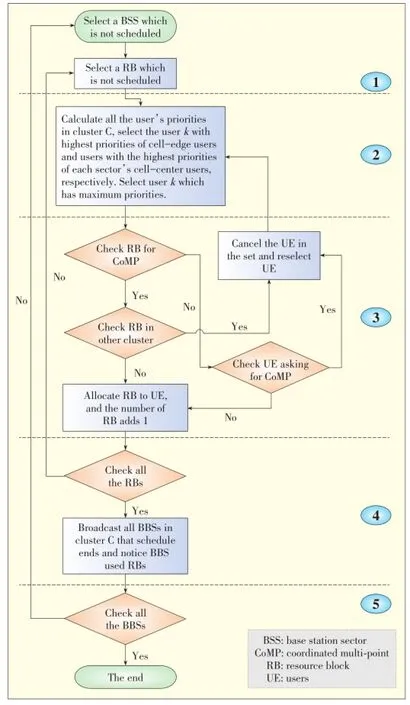
▲Figure 3.Flow chart of the proposed scheme for CoMP SU-MIMO.
With the utility-based scheduling algorithm,the proposed scheme does not need to operate the CoMP SU-MIMO transmission especially for cell-edge UEs within the CoMP frequency zone arranged at the beginning of the frequency band.Instead,it selects the better transmission mode flexibly in each resource block to maximize the frequency diversity gain of the system.Compared to a traditional scheme for CoMP,this scheme,which treats the cell-center UEs and cell-edge UEs equally in every RB,ensures fairness within the system and increases average sector throughput and cell-edge UE rates.
4.4 Scheduling Algorithm for Multiple Services
In this subsection,MUMS,a dynamic subcarrier assignment algorithm for multiple services,is formulated.According to the solution for homogeneous services in section 3.1,the scheduling algorithm for multiple services consists of three parts:
Part 1:Because the APS is prior to other services,the available subcarriers are allocated to the service at first until the HOL packet is out of[dj-d1,dj],adopting the greedy subcarrier assignment described as Algorithm 2.
Algorithm 2 greedy subcarrier allocation
1:subcarrier set:N={1,2,…,n},user set:K'={us erswhohaveAPS}
2:while(N≠∅and K'≠∅)do
3:1)find(n*,k*)=arg maxRn,k
2)assign subcarriern*to userk*
3)if the HOL packet delay is out of[dj-J1,dj]
then K=K'-{k*}
end if
4)N=N-n*
4:end while
Part 2:The remaining subcarriers are allocated among besteffort services,RPS,and CPS.Because of the total power's uniform distribution to all subcarriers,the sum power constraint of each cell can always be satisfied.Then,the optimal subcarrier allocation problem can be solved by P1.
Part 3:If userkhas RPS sensitive service,the available throughput is assigned to RPS at first until the HOL packet delay is out of[dj-d2,dj-d1].The remaining transmission bits are shared as(13).
5 Simulations Results and Discussion
5.1 Simulation Design
By conducting system-level simulations and the corresponding parameters are listed in Table 1,the performance of the cell average throughput,the cell-edge average throughput,and the utility fairness are evaluated for the proposed MUMSscheduling scheme in the CoMP-SU-MIMO system with joint transmission power control(MUMS-CJ)and in the CoMP-SUMIMO system without joint transmission power control(MUMSCNJ).For comparison,PF scheduling scheme in the non-CoMP system and in the CoMP-SU-MIMO system without joint transmission power control are considered and are called PFNCNJ and PF-CNJ,respectively.A CoMP-SU-MIMO system with 10MHz bandwidth and 19-cell hexagonal grid layout is considered.A cluster of two or three BSSs is taken into account.The path-loss model is based 3GPP TR 36.942[14]:
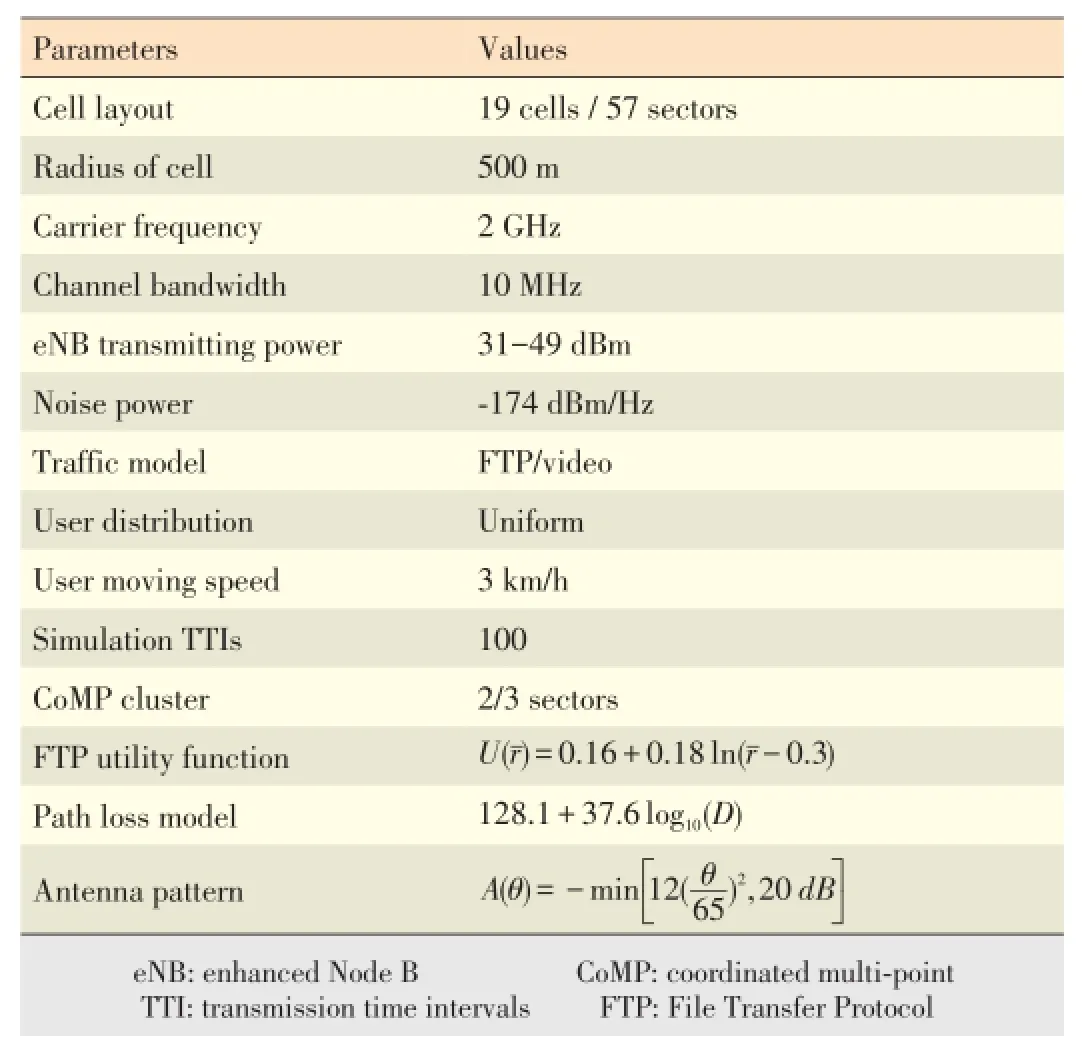
▼Table 1.Simulation parameters

where L is the pass-loss value,f is the carrier frequency in MHz,R is the distance between the BS and the user in kilometers[12],and Dhb is the height of the transmit antenna relative to the average height of the roof in meters.All base stations and users have two omni-directional antennas.In the simulations,two types of representative services are considered:video streaming(on behalf of delay-sensitive real-time service)and FTP(on behalf of best-effort service).These two kinds of service are modeled according to 3GPP recommendation.For video streaming service,the average data rata and maximum packet delay are assumed to be 128 kbps and 100 ms,respectively.Two kinds of users are assumed in the system.Kind A is a BE service user requiring only a FTP service,and kind Bis heterogeneous service user in need of a video streaming service and FTP service.We set the utility weight αj for video streaming and FTP service to 0.7 and 0.3,respectively.
5.2 Simulation Results
Fig.4 shows the cell average throughput for the four different schemes considered in this paper.The cell average throughput increases as the transmit power per base station sector increases in all four schemes.MUMS-CJ yields 17% higher cell average throughput than MUMS-CNJ,which is consistent with the joint transmission power control analysis in section 4.After adopting the joint transmission power control,the scheduled users get the biggest SINR.
Fig.5 shows the cell-edge average throughput for the four different schemes with respect to the transmit power per base station sector.First,the three schemes MUMS-CJ,MUMS-CNJ and PF-CNJ achieve higher cell-edge average throughput,which is the result of supporting CoMP joint transmission,and it can mitigate inter-cell interference and improve the celledge user throughput.The improved cell-edge performance is yielded by a better trade-off between joint transmission and interference coordination.The joint transmission power control is much more important to the better throughput performance by observing the 15.75%gain between MUMS-CNJ and MUMS -CJ.By contrasting the PF-CNJ and MUMS-CNJ we find that the proposed MUMS scheduling scheme outperforms the proportional fairness algorithm in terms of throughput.
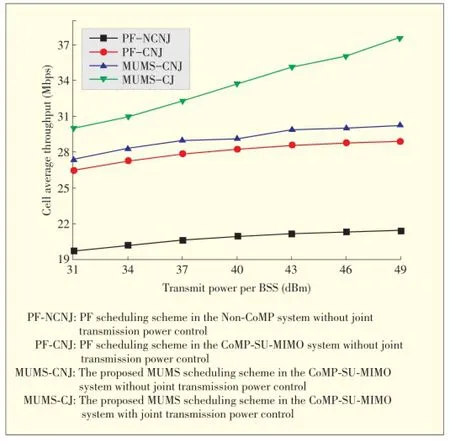
▲Figure 4.Performance comparisons on cell average throughput.
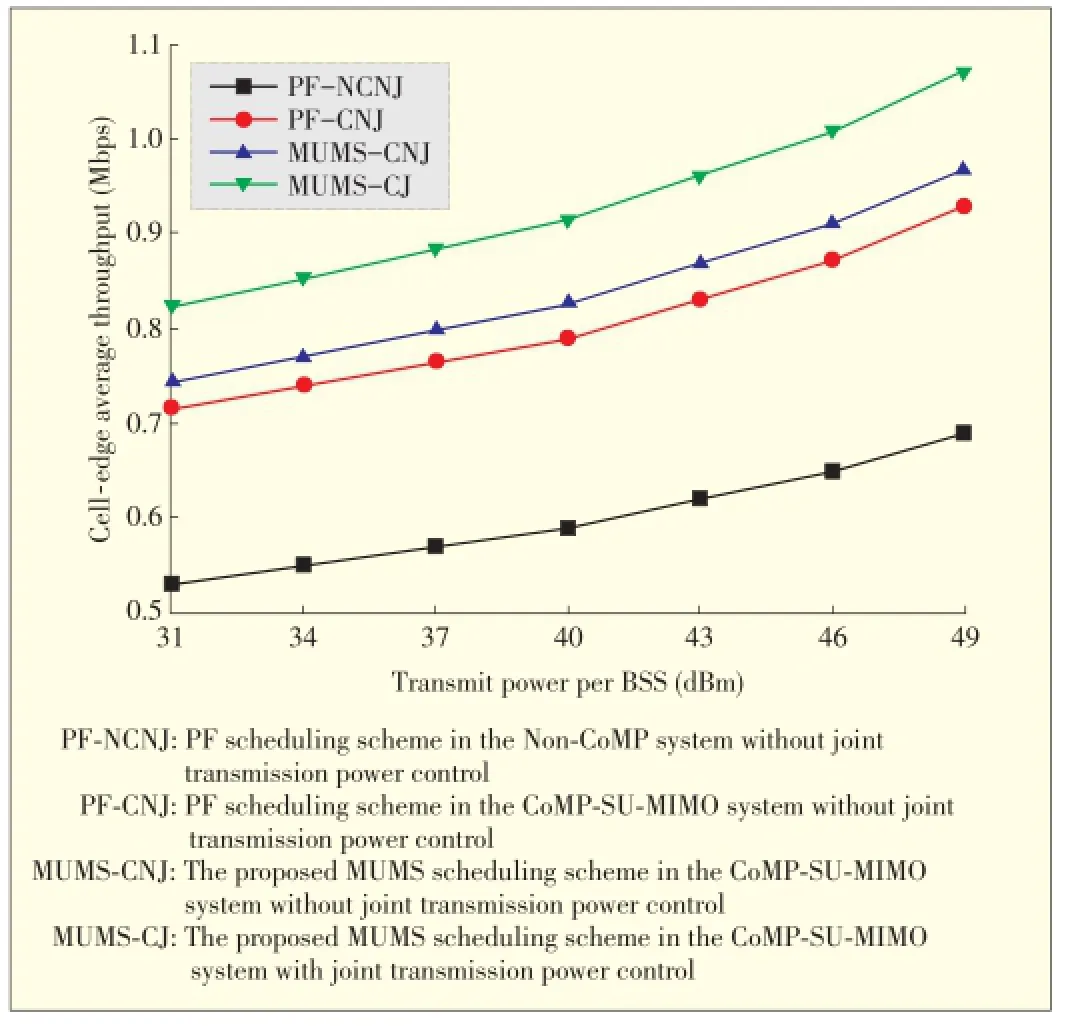
▲Figure 5.Performance comparisons on cell-edge average throughput.
To increase our understanding of the proposed MUMS scheduling algorithm designed for the CoMP-SU-MIMO system(Fig. 6),we plot the video traffic throughput of cell-edge users with respect the heterogeneous service user number in the system. The video traffic throughput of all these scheduling schemes increases as the number of heterogeneous service users increases.That of the proposed MUMS-CJ increases fastest and is obviously higher than that of the others,which indicates the MUMS can satisfy the QoS requirements of RTs well while improving the performance of the system.
We use Jain's Fairness Index(JFI)to measure the fairness of the resource scheduling scheme.The JFI is based on user utility:
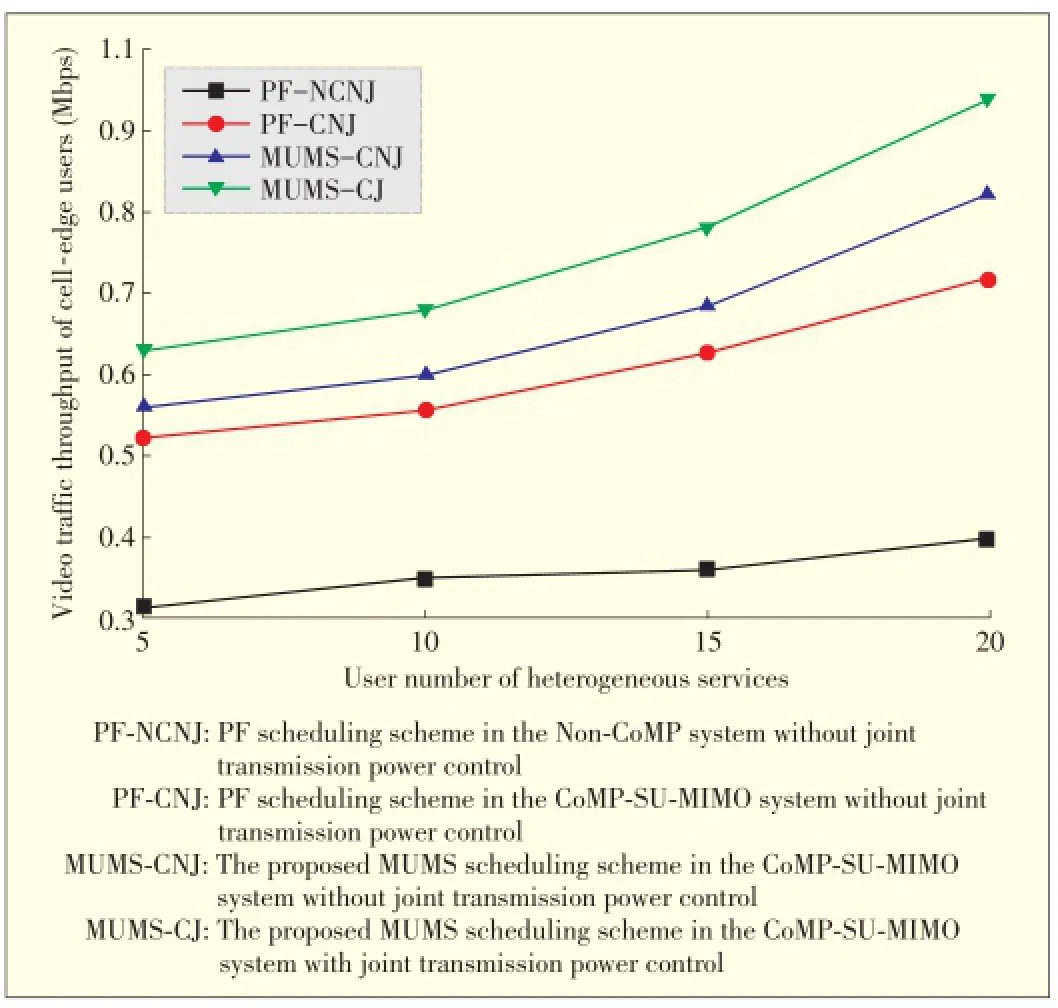
▲Figure 6.Performance comparisons on video traffic throughput of cell-edge users.

The utility JFIs of the four schemes is shown in Fig.7.By exploiting different utility functions,the proposed MUMS scheduling algorithm achieves better user utility fairness than the PF algorithm.Additionally,the joint transmission power control can also help to achieve higher utility fairness by contrast to the MUMS-CNJ and MUMS-CJ algorithms.

▲Figure 7.Performance comparisons on utility fairness index.
6 Conclusion
In this paper,we focus on the downlink of multi-cluster CoMP-SU-MIMO networks with multiple traffic patterns and provisioning QoS requirements.A utility-based joint scheduling algorithm is proposed to address the integrated problem of subcarrier allocation and dynamic subcarrier sharing between multiple services for one user.The goals of the MUMS scheme are to maximize system throughput,fulfill QoS requirements,and reduce computational complexity while considering multiple service classes.We apply JTPC to find the optimal power allocation for any selected user,which could provide most of the achievable throughput gain.The simulation results indicate a significant improvement in cell average throughput,celledge average throughput,video traffic throughput of cell-edge users and fairness criterion of the proposed MUMS-CJ.
[1]G.J.Foschini and M.J.Gans,“On the limits of wireless communications in a fading environment when using multiple antennas,”Wireless Personal Commun.,vol.6,no.3,pp.311-335,1998.doi:10.1023/A:1008889222784.
[2]I.E.Telatar,“Capacity of multi-antenna Gaussian channels,”Eur.Trans.Telecommun.,vol.10,no.6,pp.585-595,1999.doi:10.1002/ett.4460100604.
[3]W.-H.Park,S.Cho,and S.Bahk,“Scheduler design for multiple traffic classes in OFDMA networks,”Comput.Commun.,vol.31,no.1,pp.174-184,Jul. 2007.doi:10.1016/j.comcom.2007.10.041.
[4]M.Tao,Y.C.Liang,and F.Zhang,“Resource allocation for delay differentiated traffic in multiuser OFDM systems,”IEEE Trans.Wireless Commun.,vol.7,no. 6,pp.2190-2201,Jun.2008.doi:10.1109/TWC.2008.060882.
[5]Z.Chen,K.Xu,F.Jiang,Y.Wang,and P.Zhang,“Utility based scheduling algorithm for multiple services per user in mimo ofdm system,”in IEEE Int.Conf. Commun.,Beijing,China,May 2008,pp.4734-4738.doi:10.1109/ ICC.2008.887.
[6]B.Song,R.L.Cruz,and B.D.Rao,“Network duality for multiuser MIMO beamforming networks and applications,”IEEE Trans.Commun.,vol.55,no 3,pp. 618-630,2007.doi:10.1109/TCOMM.2006.888889.
[7]B.Mielczarek and W.Krzymien,“Throughput of realistic multiuser MIMOOFDM systems,”in ISSSTA,Sydney,Australia,Sep.2004,pp.434-438.doi: 10.1109/ISSSTA.2004.1371737.
[8]B.Huang,J.Li,and T.Svensson,“A utility-based scheduling approach for multiple services in coordinated multi-point networks,”in 14th Int.Symp.Wireless Personal Multimedia Commun.,Brest,France,Oct.2011,pp.1-5.
[9]N.Reider,A.Rácz,and G.Fodor,“On scheduling and power control in multicell coordinated clusters,”in IEEE Global Telecommun.Conf.,Honolulu,USA,2009,pp.1-7.doi:10.1109/GLOCOM.2009.5425622.
[10]L.Zhang and P.Lu,“A utility-based adaptive resource scheduling scheme for multiple services in downlink multiuser MIMO-OFDMA systems,”in IEEE 77th Veh.Technol.Conf.,Dresden,Germany,Jun.2013,pp.1-5.doi:10.1109/ VTCSpring.2013.6691852.
[11]J.Jang and K.B.Lee,“Transmit power adaptation for multiuser OFDM systems,”IEEE J.Sel.Areas Commun.,vol.21,no.2,pp.171-178,Feb.2003. doi:10.1109/JSAC.2002.807348.
[12]3GPP.(2004).3GPP TR 25.8923 V2.0.0:Feasibility Study for OFDM for UTRAN Enhancement.[Online].Available:http://www.docin.com/p-93113950.html
[13]C.X.Shi,Y.Wang,T.Wang,and L.S.Ling,“Resource allocation for heterogeneous services per user in OFDM distributed antenna systems,”in IEEE 71th Veh.Technol.Conf.,Taipei,China,May 2010,pp.1-5.doi: 10.1109/VETECS.2010.5493992.
[14]3GPP.(2009).3GPP TR 36.942 v8.2.0:Radio Frequency(RF)system scenarios.[Online].Available:http://www.docin.com/p-376005379.html
Manuscript received:2014-10-08
Biographiesphies
Borui Ren(zxzrbr@163.com)received his BS degree from Beijing University of Posts and Telecommunications(BUPT)in 2013.He is now a postgraduate student in Beijing University of Posts and Telecommunications.His research interests include mobile communication theory,mobile internet,and other technologies.
Gang Liu(liugang@bupt.edu.cn)received his PhD degree from BUPT in 2003. Over the past few years,he has participated as principal investigator in two National Natural Science Foundation programs.His research interests include cloud computing,speech recognition,and other technologies.He has published more than 50 papers and holds five nation invention patents.
Bin Hou(robinhou@163.com)received his PhD degree from BUPT in 2007.He currently works as a lecturer at Beijing University of Posts and Telecommunications. He has co-authoredHadoop Open Source Cloud Computing Platform.His research interests include information and network security,intelligent information processing,and data mining.
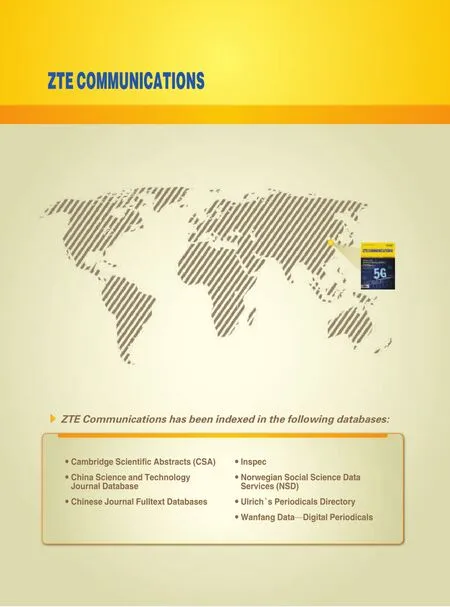
This work was partially supported by the Fundamental Research Funds for the Central Universities under Grant No.2012RC0401.
- ZTE Communications的其它文章
- Big-Data Processing Techniques and Their Challenges in Transport Domain
- Interference-Cancellation Scheme for Multilayer Cellular Systems
- An Optimal Lifetime Utility Routing for 5G and Energy-Harvesting Wireless Networks
- Energy-Efficient Large-Scale Antenna Systems with Hybrid Digital-Analog Beamforming Structure
- Signal Processing Techniques for 5G:An Overview
- 5G:Vision,Scenarios and Enabling Technologies

